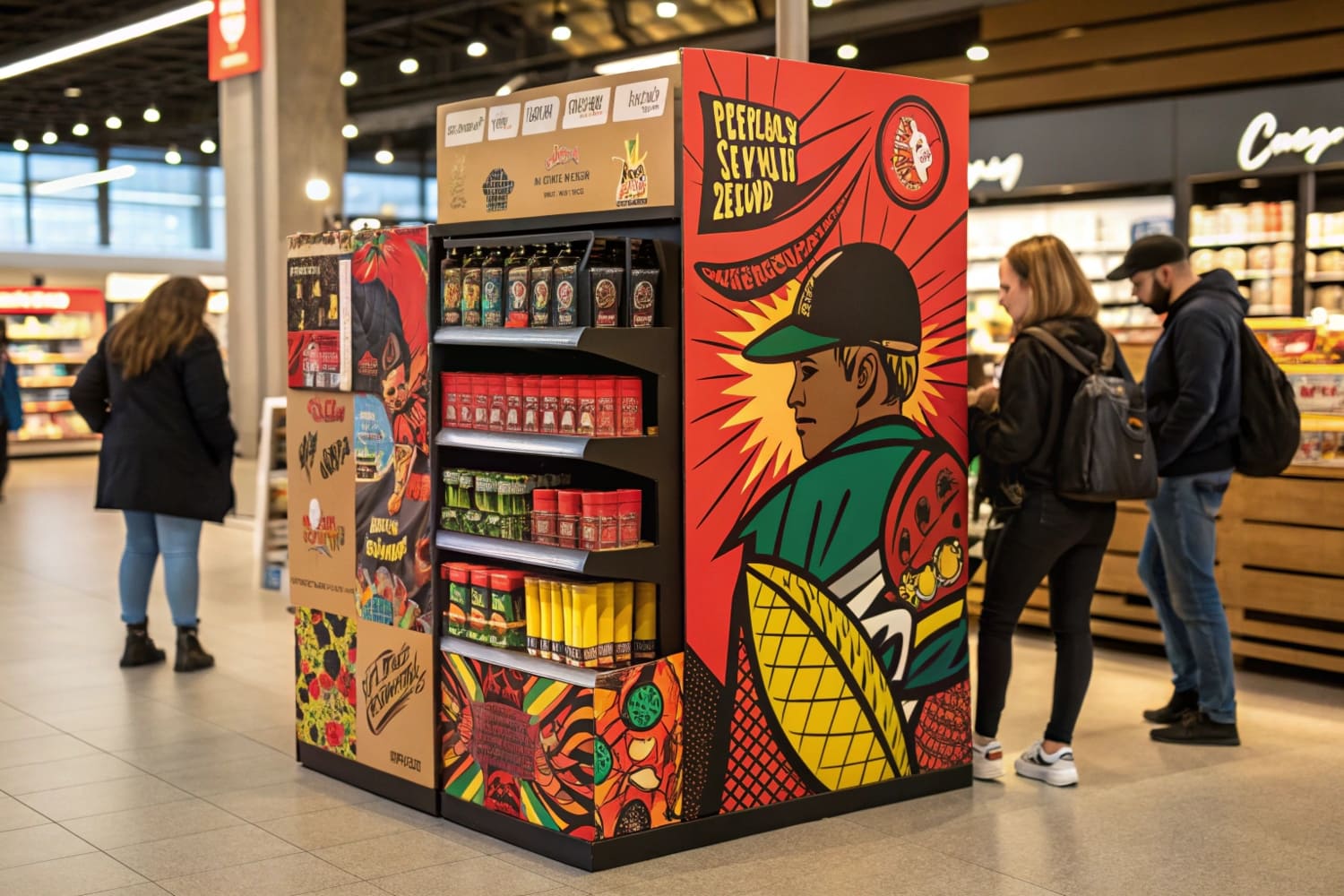আপনি চান পণ্যগুলো সবার নজরে আসুক, কিন্তু জায়গা কম। বাজেট কমে যাচ্ছে। সময়সীমা কমে যাচ্ছে। কাস্টম POP ডিসপ্লে পরিষ্কার কাঠামো, দ্রুত মুদ্রণ এবং সহজ অ্যাসেম্বলির মাধ্যমে এই সমস্যার সমাধান করে।
কাস্টম POP ডিসপ্লে হল ব্র্যান্ডেড, অস্থায়ী বা আধা-স্থায়ী ফিক্সচার যা পণ্যের কাছে রাখা হয় যাতে মনোযোগ আকর্ষণ করা যায় এবং আবেগ বা পরিকল্পিত কেনাকাটা চালানো যায়। এগুলি কার্ডবোর্ড বা ঢেউতোলা বোর্ড ব্যবহার করে, দ্রুত মুদ্রণ করা হয়, সমতলভাবে পাঠানো হয়, দ্রুত একত্রিত করা হয় এবং একটি SKU, একটি ঋতু বা একটি সম্পূর্ণ লঞ্চের জন্য তৈরি করা যেতে পারে।
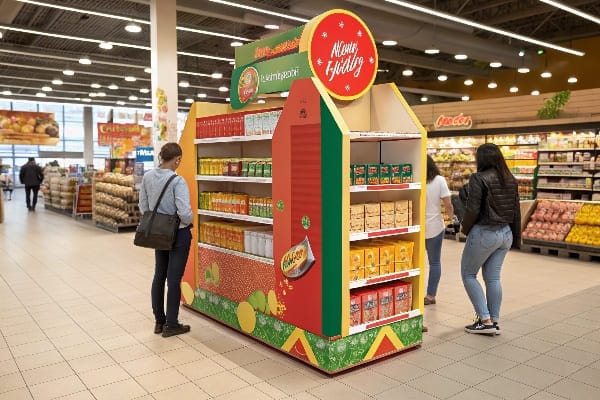
আমি এই নির্দেশিকাটি সহজ এবং কার্যকর রাখি। ক্রেতারা আমাকে কলে যে মূল প্রশ্নগুলি জিজ্ঞাসা করেন আমি তার উত্তর দিই। কারখানার মেঝেতে কী কাজ করে, কী ব্যর্থ হয় এবং কীভাবে এটি ঠিক করি তা আমি ভাগ করে নিই।
পপ ডিসপ্লে কী?
ক্রেতারা তাকগুলি দ্রুত স্ক্যান করে। প্যাকেজগুলি ঝাপসা হয়ে যায়। একটি POP ডিসপ্লে চোখ আটকে দেয় এবং একটি পছন্দ ফ্রেম করে। এটি একটি গল্প, একটি সুবিধা এবং একটি ক্রিয়া তুলে ধরে।
একটি POP ডিসপ্লে হল একটি ইন-স্টোর পণ্য উপস্থাপনা যা দৃশ্যমানতা এবং রূপান্তর বৃদ্ধির জন্য পণ্যের অবস্থানের কাছাকাছি বা কাছাকাছি রাখা হয়। এটি একটি মেঝে, প্যালেট, শেল্ফ, অথবা কাউন্টারটপ ইউনিট হতে পারে, যা ব্র্যান্ড এবং স্টোরের নিয়ম অনুসারে মুদ্রিত এবং কাটা হয়।
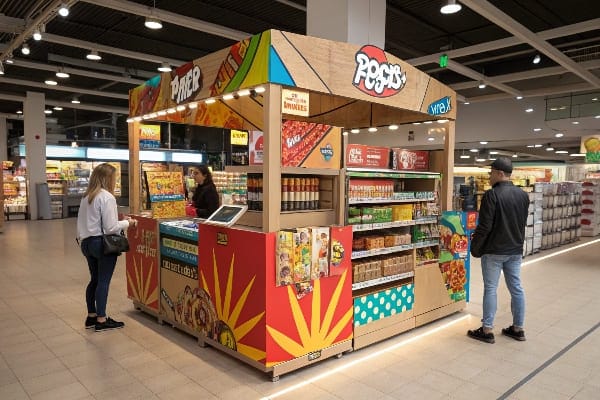
প্রকারভেদ, ব্যবহারের ধরণ এবং কেন তারা কাজ করে
আমি কার্ডবোর্ড ব্যবহার করি কারণ এটি হালকা, ওজনের জন্য শক্তিশালী এবং মুদ্রণ করা সহজ। আমি ট্যাবগুলি কাটি, ভাঁজ করি এবং লক করি। মালবাহী খরচ এবং ক্ষতি কমাতে আমি ফ্ল্যাট শিপিং করি। ফ্লোর ডিসপ্লেগুলি প্রায়শই সর্বোচ্চ লিফট টানে কারণ এগুলি একা দাঁড়িয়ে থাকে এবং জায়গার মালিক। কাউন্টার ইউনিটগুলি চেকআউটে জয়লাভ করে কারণ তারা ট্র্যাফিক চালায়। প্যালেট ডিসপ্লে গুদাম ক্লাবগুলিতে দ্রুত অবতরণ করে। শেল্ফ ট্রেগুলি মুখের সাথে সাহায্য করে এবং প্যাকগুলি সারিবদ্ধ রাখে। হ্যাং স্ট্রিপগুলি ছোট আইটেম বিক্রি করে যেখানে তাকগুলি পূর্ণ থাকে। যখন ব্রিফের আরও গল্পের প্রয়োজন হয় তখন আমি QR কোড, ছোট আলো বা সেন্সরও যোগ করি। একটি শিল্প প্রতিবেদনে, ফ্লোর ইউনিটগুলি POP এর একটি বড় অংশ দখল করে কারণ তারা শক্তিশালী থামার শক্তি তৈরি করে। এটি আমি প্রতিদিনের অর্ডার এবং পুনঃক্রমের ক্ষেত্রে যা দেখি তার সাথে মিলে যায়।
| প্রকার | সেরা ব্যবহার | কেন এটি কাজ করে | আমার লাইন থেকে নোট |
|---|---|---|---|
| মেঝে প্রদর্শন1 | নতুন লঞ্চ, বান্ডেল | জায়গার মালিক, বড় গ্রাফিক্স | জাহাজগুলি সমতল, দ্রুত সেট আপ করা যায় |
| কাউন্টারটপ ডিসপ্লে2 | ছোট, আবেগপ্রবণ জিনিসপত্র | পেমেন্টের কাছাকাছি, দ্রুত সিদ্ধান্ত | ছোট ছোট রানের ফল পাওয়া যায় |
| প্যালেট প্রদর্শন3 | ক্লাব, প্রচারণা, বড় পরিমাণে | দ্রুত, উচ্চ মজুদ ক্ষমতা হ্রাস | শক্ত কোণার খুঁটি প্রয়োজন |
| শেল্ফ ট্রে/PDQ4 | মুখের অংশ, ছোট প্যাকগুলি সাজান | পরিপাটি ব্লক, সহজেই পুনরায় পূরণ করা যায় | ডাই-কাট জানালা সাহায্য |
| হ্যাং ট্যাব/ক্লিপ স্ট্রিপ | হালকা অ্যাড-অন SKU গুলি | ডেড স্পেস ব্যবহার করে, ক্রস-সেল করে | হুকের শক্তি পরীক্ষা করুন |
| ইন্টারেক্টিভ ইউনিট5 | প্রিমিয়াম স্টোরি বা ডেমো | শিক্ষিত করে, মাইক্রো-সিগন্যাল সংগ্রহ করে | বিদ্যুৎ বা ব্যাটারি অদলবদলের পরিকল্পনা করুন |
আমি এটা শিখেছি শিকারের মৌসুমের লঞ্চের সময়। আমরা একটি লম্বা ক্রসবো ফ্লোর ডিসপ্লে 6 যার মোটা কপি এবং স্পষ্ট নিরাপত্তা নোট 7 । বিক্রিযোগ্য ডিসপ্লেটি কেবল শেল্ফ-ভিত্তিক দোকানগুলিকে একটি বিশাল ফাঁক দিয়ে ছাড়িয়ে গেছে। ইউনিটটি পুরো মরসুম টিকেছিল শুধুমাত্র একটি টপ কার্ডের বিনিময়ে।
পপ ডিসপ্লের অসুবিধাগুলি কী কী?
প্রতিটি টুলেরই সীমাবদ্ধতা আছে। POP ডিসপ্লেগুলিও আলাদা নয়। যদি আপনি এগুলিকে খুব বেশি দূরে ঠেলে দেন, তাহলে এগুলি বাঁকবে, ঘর্ষণ করবে, অথবা দেরিতে পৌঁছাবে।
POP ডিসপ্লেগুলির দীর্ঘমেয়াদী স্থায়িত্বের অভাব হতে পারে, আর্দ্রতা এবং পরিবহন ঝুঁকির সম্মুখীন হতে পারে, ব্যস্ত মেঝেতে সেটআপের সময় বৃদ্ধি করতে পারে এবং নমুনা এবং ব্যাপক উৎপাদনের মধ্যে প্রিন্টের রঙ বা উপকরণের বিচ্যুতি ঘটলে ক্ষতি হতে পারে। সময়সীমার আঁটসাঁটতা এই সমস্যাগুলিকে আরও খারাপ করে তুলতে পারে।
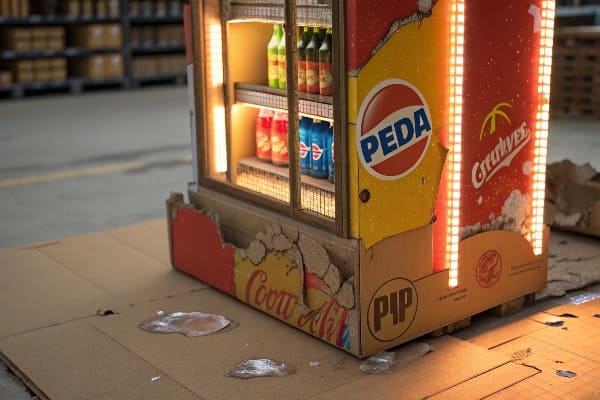
আমি যেসব ঝুঁকি লক্ষ্য করি এবং কীভাবে সেগুলি কমাবো
আমি বাস্তব জগতের জন্য ডিজাইন করি, শুধু রেন্ডার নয়। ঢেউতোলা বোর্ড জল এবং রুক্ষ হ্যান্ডলিং ঘৃণা করে, তাই আমি কোটিং এবং ইঞ্জিনিয়ার জয়েন্ট বেছে নিই। আমি বালির ব্যাগ দিয়ে লোড পরীক্ষা করি। আমি কুরিয়ার অপব্যবহারের অনুকরণ করার জন্য বাক্সগুলি ঝাঁকি। আমি ড্রডাউন এবং স্বাক্ষরিত মান দিয়ে রঙগুলি লক করি। আমি মানুষের সময়ের জন্যও পরিকল্পনা করি। স্টোর টিমের কাছে ঘন্টা নয়, মিনিট থাকে, তাই আমি অংশ গণনা করি এবং স্পষ্ট স্টিকার এবং সংখ্যা ব্যবহার করি। আর্দ্রতা প্রান্তগুলিকে নষ্ট করে, তাই পরিবেশের চাহিদা অনুসারে জল-ভিত্তিক বার্নিশ 8 মধুচক্র প্যাড 9 । রঙের প্রবাহ বিশ্বাসকে আঘাত করে, তাই আমি নমুনা থেকে বাল্ক পর্যন্ত একই সাবস্ট্রেট এবং কালি সেট চালাই। আমি এটিকে পরিষেবা নিয়মে রাখি যা আমার দল প্রতিটি প্রকল্পে অনুসরণ করে।
| ইস্যু | এটা দেখতে কেমন লাগে | আমি যে সিম্পল ফিক্স ব্যবহার করি | বিনিময় |
|---|---|---|---|
| ভেজা এলাকায় স্থায়িত্ব10 | নরম প্রান্ত, ঝুলে পড়া তাক | বার্নিশ/ন্যানো-কোট, শক্তিশালী বাঁশি | সামান্য খরচ বৃদ্ধি |
| শিপিং ক্ষতি11 | ভাঙ্গা কোণ, বাঁকানো হেডার | কোণার পোস্ট, আরও শক্ত ভেতরের প্যাক | মালবাহী খরচ কিছুটা বেশি |
| ধীরগতির স্টোর অ্যাসেম্বলি | অতিরিক্ত যন্ত্রাংশ, অস্পষ্ট পদক্ষেপ | কম অংশ, বড় ধাপের লেবেল | কম ভাস্কর্যযুক্ত জ্যামিতি |
| রঙের অসঙ্গতি | লোগো অফ-শেড, ম্লান কালো | স্বাক্ষরিত ড্রডাউন, সাবস্ট্রেট লক | দীর্ঘ প্রিপ্রেস পর্যায় |
| নমুনা-পরবর্তী উপাদান সুইচ | বাল্কে ফ্লিমসিয়ার বোর্ড | PO-তে জমাটবদ্ধ নমুনা স্পেক | ক্রয়ের সীমাবদ্ধতা |
| আর্দ্রতা বা UV এক্সপোজার | বিবর্ণ, বিকৃত | ইউভি কালি, টপ কোট, আরও ভালো প্লেসমেন্ট | অতিরিক্ত প্রক্রিয়া সময় |
একটি সত্য ঘটনা: একজন ক্লায়েন্ট তাড়াহুড়ো করে দেশব্যাপী পণ্যের দাম কমে গেল। প্রথম ব্যাচটি পরিবহনের সময় নষ্ট হয়ে গেল। আমরা একটি কম দামের স্লিভ ১২ এবং একটি শক্ত টপ কোট ১৩ । দ্বিতীয় ব্যাচটি টিকে ছিল এবং লক্ষ্যমাত্রা পূরণ করেছিল।
POS এবং POP প্রদর্শনের মধ্যে পার্থক্য কী?
মানুষ সভাগুলোতে উভয় শব্দ ব্যবহার করে। ধারণাগুলি একে অপরের সাথে মিলে যায়। লক্ষ্যগুলি এক নয়।
পণ্যের কাছে POP ডিসপ্লে থাকে যা পণ্যের নির্বাচনকে প্রভাবিত করে। POS ডিসপ্লেগুলি বিক্রয়ের স্থানে থাকে, চেকআউটের মতো, শেষ-সেকেন্ডের অ্যাড-অনগুলি ট্রিগার করার জন্য। POP বিবেচনা চালায়; POS পেমেন্টের সময় আবেগ চালায়।
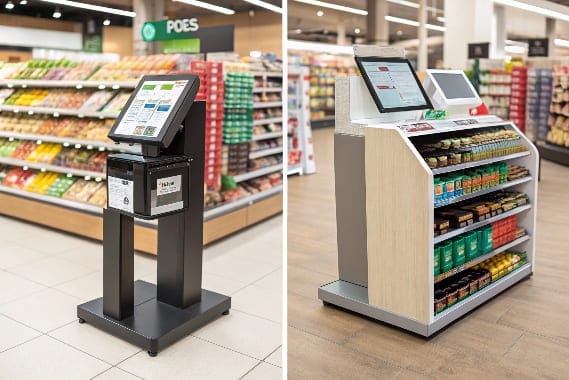
প্রত্যেকে কোথায় থাকে এবং আমি কীভাবে বেছে নিই
আমি POP 14 যেখানে ক্রেতা বিকল্পগুলির তুলনা করে। আমি POS রাখি যেখানে ক্রেতা অর্থ প্রদান করে। POP আরও গল্প এবং স্পেসিফিকেশন ধারণ করে। POS গতি এবং দামের উপর ফোকাস করে। শিকারের সরঞ্জামের জন্য, ক্রসবোর জন্য একটি POP এন্ডক্যাপ ড্রয়ের ওজন, সুরক্ষা এবং প্যাকেজের বিষয়বস্তু দেখাতে পারে। একটি POS ডিসপ্লেতে দ্রুত অ্যাড-অনের জন্য মোম, স্ট্রিং বা ছোট আনুষাঙ্গিক থাকতে পারে। সময়ও ভিন্ন। POP প্রায়শই একটি নতুন পণ্যের মরসুমের সাথে চালু হয়। POS ছোট প্রোমো এবং উপহারের শিখর সহ ঘোরে। ক্রেতারা যখন আমাকে জিজ্ঞাসা করে যে কোনটি বেছে নিতে হবে, আমি মার্জিন, টিকিটের আকার এবং প্ল্যানোগ্রাম দেখি। যদি SKU-এর শিক্ষার প্রয়োজন হয়, আমি POP-কে এগিয়ে নিই। যদি এটি একটি কম-ঘর্ষণ রিফিল হয়, আমি POS-কে এগিয়ে নিই। উভয়ই একটি ভিজ্যুয়াল সিস্টেম ভাগ করতে পারে যাতে ব্র্যান্ডটি আইল থেকে চেকআউট পর্যন্ত একই রকম অনুভব করে।
| দৃষ্টিভঙ্গি | POP ( পয়েন্ট-অফ-পারচেজ ১৫ ) | পিওএস ( পয়েন্ট-অফ-সেল ১৬ ) |
|---|---|---|
| স্থাপন | আইল, এন্ডক্যাপ, কাছাকাছি ক্যাটাগরি | চেকআউট, সার্ভিস কাউন্টার |
| লক্ষ্য | বিবেচনা, তুলনা, বিনিময় | আবেগ, সংযুক্তি, ঝুড়ির আকার |
| বার্তা | বৈশিষ্ট্য, সুবিধা, ব্যবহারের ক্ষেত্রে | দাম, ডিল, দ্রুত সুবিধা |
| সময় বাস | দীর্ঘতর | খুব ছোট |
| কাঠামো | মেঝে/প্যালেট/শেল্ফ/কাউন্টার ইউনিট | ছোট কাউন্টার ট্রে, ক্লিপ স্ট্রিপ |
| মেট্রিক্স | রূপান্তর লিফট, তাকের ভাগ | প্রতি লেনদেনের জন্য ইউনিট, রেট সংযুক্ত করুন |
আমি এই খেলাটি দেখেছি একটি ক্লাব প্যালেট দিয়ে একটি বো বান্ডেল ১৭ এবং একটি কাউন্টার ট্রে দিয়ে। প্যালেটটি বান্ডেলের ট্রায়াল চালায়। POS ট্রে ১৮ সংযুক্তির হার বাড়িয়েছে। উভয়ই একই সাহসী গ্রাফিক সিস্টেম ব্যবহার করেছে, তাই ক্রেতারা আইল থেকে চেকআউট পর্যন্ত একটি পরিষ্কার পথ অনুভব করেছে।
কে সাধারণত পপ ডিসপ্লে সরবরাহ করে?
অনেক দল একটি ডিসপ্লে সরবরাহ করতে পারে। সেরা পছন্দটি গতি, নিয়ন্ত্রণ এবং বাজেটের উপর নির্ভর করে।
POP ডিসপ্লে সাধারণত বিশেষায়িত ডিসপ্লে নির্মাতারা, ডিসপ্লে ইউনিট সহ প্যাকেজিং কনভার্টার, খুচরা বিপণন সংস্থা, অথবা অনুমোদিত বিক্রেতা প্রোগ্রাম সহ খুচরা বিক্রেতারা সরবরাহ করে; ব্র্যান্ডগুলি খরচ, গতি, নকশা নিয়ন্ত্রণ এবং স্টোর সম্মতির উপর ভিত্তি করে নির্বাচন করে।
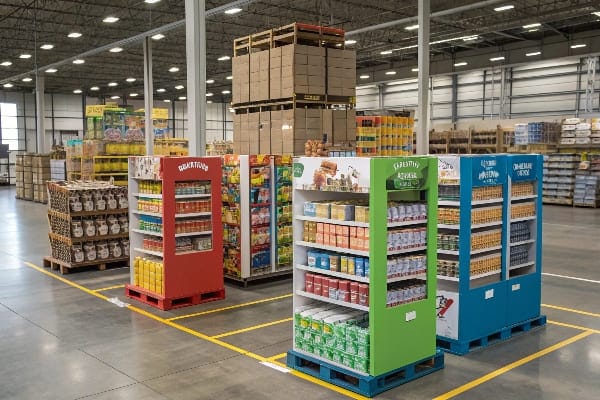
সরবরাহ মডেল এবং আমি প্রতিটির সাথে কীভাবে কাজ করি
আমি একজন প্রস্তুতকারক হিসেবে ডিসপ্লে সরবরাহ করি। আমি তিনটি প্রোডাকশন লাইন ১৯। আমি ডিজাইন, প্রোটোটাইপ, পরীক্ষা এবং গণ উৎপাদন করি। কিছু ব্র্যান্ড এজেন্সি পছন্দ করে। এজেন্সিগুলি ক্রেতা গবেষণা এবং খুচরা প্রোগ্রাম পরিচালনা করে, তারপর আমার মতো সংক্ষিপ্ত কারখানাগুলি পরিচালনা করে। কিছু খুচরা বিক্রেতা কঠোরভাবে অনুমোদিত তালিকা পরিচালনা করে। সেক্ষেত্রে, আমি আমার ডায়ালাইন এবং উপকরণগুলিকে তাদের নিয়ম অনুসারে সারিবদ্ধ করি, তারপর আমি লোড এবং পরিবহনের জন্য পরীক্ষায় উত্তীর্ণ হই। দ্রুত চক্রের জন্য, প্রস্তুতকারক-প্রত্যক্ষ সবচেয়ে ভালো। এটি হ্যান্ডঅফ কমিয়ে দেয়। মিডিয়া এবং ডেটা সহ জটিল লঞ্চের জন্য, এজেন্সি-পরিচালিত ২০ সাহায্য করতে পারে।
| মডেল | শক্তি | নজরদারি | যখন আমি এটি সুপারিশ করি |
|---|---|---|---|
| প্রস্তুতকারক-সরাসরি21 | দ্রুত, কম খরচে, কঠোর স্পেক নিয়ন্ত্রণ | ব্র্যান্ডকে স্পষ্টভাবে সংক্ষিপ্ত বিবরণ দিতে হবে | কঠোর সময়সীমা, স্পষ্ট সুযোগ |
| এজেন্সি-পরিচালিত22 | কৌশল, সৃজনশীল, বহু-বাজার রোলআউট | আরও স্তর এবং ফি | জটিল প্রোগ্রাম, গবেষণার চাহিদা |
| হাইব্রিড | এজেন্সি ডিজাইন + ফ্যাক্টরি ডিএফএম + দ্রুত পাইলট | হ্যান্ডঅফ কঠোর হতে হবে | পুনরাবৃত্তিমূলক পাইলট, পরে স্কেল করুন |
| খুচরা বিক্রেতা-নেতৃত্বাধীন | সম্মতি, পরীক্ষিত ফর্ম্যাট | নকশার স্বাধীনতা কম | শৃঙ্খল আদেশ, কঠোর পরীক্ষা |
আমার প্রক্রিয়াটি এখানে দেওয়া হল যাতে আপনি বুঝতে পারেন কী আশা করতে পারেন। আমি কাঠামো এবং দ্রুত 3D রেন্ডার দিয়ে শুরু করি। আমি বিনামূল্যে পরিবর্তন সহ এটি পর্যালোচনার জন্য পাঠাই। আমি একটি কার্যকরী নমুনা তৈরি করি। আমি লোড এবং পরিবহন পরীক্ষা করি। আমি একটি স্বাক্ষরিত লক্ষ্যের সাথে রঙ মেলাই। নমুনা অনুমোদিত হওয়ার পরে আমি কেবল 23 মাস পরে ভর রান । আমি স্পষ্ট ধাপের লেবেল সহ ফ্ল্যাট শিপিং করি। আমি পুনরাবৃত্তি অর্ডারের উপর মনোযোগ দিই, তাই আমি নকশা বা নমুনা নেওয়ার সময় ছোট ছোট ক্ষতি গ্রহণ করি। আমি মার্কিন যুক্তরাষ্ট্র, কানাডা, যুক্তরাজ্য এবং অস্ট্রেলিয়ায় রপ্তানি করি। আমি B2B কাজ করি, শুধুমাত্র 24 । আমি উপাদান শক্তি পরীক্ষা, মুদ্রণ লক্ষ্য এবং কারখানার সার্টিফিকেশন অডিটের জন্য প্রস্তুত রেখে গুণমানকে উচ্চ রাখি। এই কারণেই কঠোর তারিখ সহ ক্রেতারা, যেমন শিকারের ব্র্যান্ডগুলি যা মরসুমের আগে চালু হয়, প্রতি বছর ফিরে আসে।
উপসংহার
কাস্টম POP ডিসপ্লে মনোযোগ আকর্ষণ করে, বিক্রয় বৃদ্ধি করে এবং দ্রুত স্কেল বৃদ্ধি করে। সঠিক ধরণটি বেছে নিন, ঝুঁকির জন্য পরিকল্পনা করুন এবং এমন একটি সরবরাহকারী বেছে নিন যার নকশা, পরীক্ষা এবং সময় নির্ধারণের ক্ষমতা রয়েছে।
আপনার খুচরা বাজারে মেঝে প্রদর্শনের প্রভাব সর্বাধিক করার জন্য কার্যকর কৌশলগুলি আবিষ্কার করতে এই সংস্থানটি অন্বেষণ করুন। ↩
কাউন্টারটপ ডিসপ্লে কীভাবে ক্রয়ের প্রবণতা বৃদ্ধি করতে পারে এবং গ্রাহকের অভিজ্ঞতা উন্নত করতে পারে তা বুঝতে এই লিঙ্কটি ঘুরে দেখুন। ↩
প্যালেট ডিসপ্লের প্রভাব এবং বিক্রয় সর্বাধিক করার কার্যকর কৌশলগুলি শিখতে এই সংস্থানটি অন্বেষণ করুন। ↩
খুচরা পরিবেশে শেল্ফ ট্রে কীভাবে সংগঠন এবং বিক্রয় দক্ষতা বৃদ্ধি করে তা বুঝতে এই লিঙ্কটি ঘুরে দেখুন। ↩
ইন্টারেক্টিভ ইউনিটগুলি কীভাবে গ্রাহকদের শিক্ষিত করতে পারে এবং মূল্যবান অন্তর্দৃষ্টি সংগ্রহ করতে পারে, আপনার বিপণন কৌশলকে উন্নত করতে পারে তা আবিষ্কার করুন। ↩
কীভাবে একটি ক্রসবো ফ্লোর ডিসপ্লে আপনার দোকানে দৃশ্যমানতা এবং বিক্রয় বৃদ্ধি করতে পারে তা আবিষ্কার করুন। ↩
আপনার খুচরা পরিবেশে নিরাপত্তা নোট অন্তর্ভুক্ত করলে গ্রাহকদের আস্থা এবং সম্মতি কেন উন্নত হতে পারে তা জানুন। ↩
জল-ভিত্তিক বার্নিশ কীভাবে প্যাকেজিংয়ের স্থায়িত্ব বাড়াতে পারে এবং আর্দ্রতা থেকে রক্ষা করতে পারে তা বুঝতে এই লিঙ্কটি দেখুন। ↩
পরিবহনের সময় কাঠামোগত সহায়তা এবং সুরক্ষা প্রদানে মধুচক্র প্যাড এবং তাদের ভূমিকা সম্পর্কে জানুন। ↩
এই লিঙ্কটি ঘুরে দেখুন এবং কার্যকর আবরণ আবিষ্কার করুন যা আর্দ্র পরিবেশে স্থায়িত্ব বাড়ায় এবং দীর্ঘস্থায়ী কর্মক্ষমতা নিশ্চিত করে। ↩
শিপিং ক্ষতি রোধ করার জন্য বিশেষজ্ঞ টিপসের জন্য এই রিসোর্সটি দেখুন, যাতে আপনার পণ্যগুলি নিখুঁত অবস্থায় পৌঁছায়। ↩
কীভাবে একটি কম দামের স্লিভ পণ্যের সুরক্ষা বাড়াতে পারে এবং প্যাকেজিংয়ের খরচ কমাতে পারে তা আবিষ্কার করুন। ↩
আপনার পণ্যের স্থায়িত্ব এবং গুণমান বৃদ্ধির জন্য শক্ত টপ কোটের সুবিধা সম্পর্কে জানুন। ↩
POP বোঝা আপনার খুচরা কৌশলকে উন্নত করতে পারে, যা আপনাকে কার্যকরভাবে গ্রাহকদের সাথে যুক্ত করতে এবং বিক্রয় বৃদ্ধি করতে সহায়তা করে। ↩
পারচেজ পয়েন্ট বোঝা আপনার বিপণন কৌশলগুলিকে উন্নত করতে পারে এবং বিক্রয় কার্যকারিতা উন্নত করতে পারে। ↩
পয়েন্ট-অফ-সেল সিস্টেমগুলি অন্বেষণ লেনদেনকে সুগম করতে এবং গ্রাহক সন্তুষ্টি বাড়াতে সাহায্য করতে পারে। ↩
এই লিঙ্কটি অন্বেষণ করলে কীভাবে ধনুকের বান্ডিল বিক্রয় এবং গ্রাহকদের সম্পৃক্ততা বৃদ্ধি করতে পারে সে সম্পর্কে অন্তর্দৃষ্টি পাওয়া যাবে। ↩
এই রিসোর্সটি সংযুক্তির হার এবং সামগ্রিক বিক্রয় বৃদ্ধিতে POS ট্রের কার্যকারিতা ব্যাখ্যা করবে। ↩
একাধিক উৎপাদন লাইন কীভাবে উৎপাদন প্রক্রিয়ায় দক্ষতা এবং নমনীয়তা বৃদ্ধি করতে পারে তা বুঝতে এই লিঙ্কটি অন্বেষণ করুন। ↩
এজেন্সি-পরিচালিত উৎপাদন সম্পর্কে অন্তর্দৃষ্টি আবিষ্কার করুন এবং দেখুন কিভাবে এটি জটিল লঞ্চগুলিকে সহজতর করতে পারে এবং প্রকল্পের ফলাফল উন্নত করতে পারে। ↩
নির্মাতা-প্রত্যক্ষ মডেলগুলি কীভাবে দক্ষতা বৃদ্ধি করতে পারে এবং খরচ কমাতে পারে তা বুঝতে এই লিঙ্কটি অন্বেষণ করুন। ↩
সৃজনশীলতা এবং বহু-বাজার কার্যকারিতা কাজে লাগানোর জন্য এজেন্সি-পরিচালিত কৌশলগুলির অন্তর্দৃষ্টি আবিষ্কার করুন। ↩
ব্যাপক উৎপাদন ব্যবস্থাপনা, গুণমান এবং দক্ষতা নিশ্চিত করার কার্যকর কৌশলগুলি বুঝতে এই লিঙ্কটি অন্বেষণ করুন। ↩
আপনার ব্যবসায়িক কৌশল উন্নত করতে এবং লাভজনকতা উন্নত করতে B2B পাইকারি মডেলগুলির অন্তর্দৃষ্টি আবিষ্কার করুন। ↩

